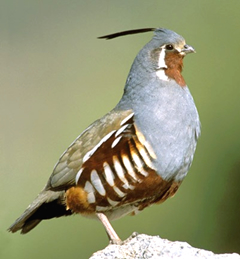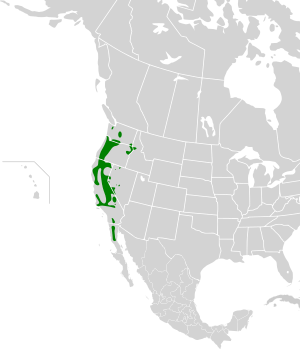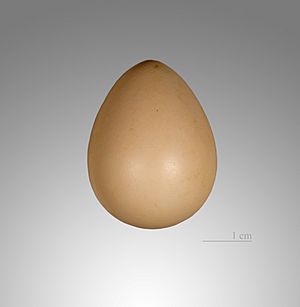Mountain quail facts for kids
Quick facts for kids Mountain quail |
|
|---|---|
 |
|
| Male | |
| Conservation status | |
| Scientific classification | |
| Genus: |
Oreortyx
|
| Species: |
pictus
|
 |
|
The mountain quail (Oreortyx pictus) is a small bird that lives on the ground. It belongs to the New World quail family. This bird is the only one in its group, called Oreortyx. Scientists believe its family tree separated from other quails a long time ago, about 6 million years ago.
Contents
Description
Mountain quails are about 26 to 28 centimeters (10 to 11 inches) long. Their wingspan is usually between 35 and 40 centimeters (14 to 16 inches). They have short, rounded wings and long legs without feathers.
You can easily spot them by the small feathery top knot on their heads. This top knot is shorter on the female birds. They have a brown face, a gray chest, and a brown back. Their underside has clear white stripes.
Subspecies
There are five different types, or subspecies, of mountain quail. Each type lives in a slightly different area:
- O. p. pictus – This type is found from the Cascade Range in Washington down to the coastal mountains of central California.
- O. p. plumifer – This type lives from southern Washington to western Nevada and central California.
- O. p. russelli – Also known as the pallid mountain quail, it lives in the Little San Bernardino Mountains of southern California.
- O. p. eremophilus – Called the desert mountain quail, it is found in the Sierra Nevada mountains from southern California to northern Baja, and a small part of southwestern Nevada.
- O. p. confinis – This type, the southern mountain quail, lives in the mountains of northern Baja California.
Distribution and Habitat
Mountain quails live in mountain areas with chaparral plants. You can find them west of the Rocky Mountains. Their home range stretches from British Columbia in Canada down through parts of Washington state in the United States, all the way to the Baja Peninsula in Mexico.
They can live at high places, up to 3,000 meters (about 9,800 feet) above sea level. These birds usually do not migrate (move to different places for seasons). However, some groups might move to lower or higher elevations depending on the mountain range.
Behaviour
Mountain quails mostly get around by walking. They can move surprisingly fast through thick bushes and plants. In late summer, fall, and winter, adult quails and their young gather in family groups. These groups can have up to 20 birds.
Mountain quails can be quite secretive. When they do fly, it's usually a short, fast burst. They flap their wings many times quickly, then glide slowly back to the ground.
Feeding
The main part of a mountain quail's diet is plants and seeds. Young chicks eat more insects than adult quails. As they grow older, they start to eat more and more plant material.
Reproduction
Mountain quails usually have one partner for breeding, which is called monogamous. The female bird typically lays 9 to 10 eggs. She makes a simple nest by scraping a shallow hole in the ground. This nest is hidden in plants, often at the bottom of a tree or shrub, usually near water.
The eggs hatch after 21 to 25 days. The female usually sits on the eggs to keep them warm, but sometimes the male helps. The chicks are precocial, meaning they can leave the nest with their parents just hours after they hatch.
Status and Conservation
The IUCN says that the mountain quail is not a threatened species. There are many of them across their wide range. However, their survival depends on having enough good habitat. Their habitat tends to grow in cooler and drier climates.
See also
In Spanish: Colín serrano para niños




